Ket people
Kets (Russian: кеты; Ket: кето, кет, денг) are a Yeniseian-speaking people in Siberia. During the Russian Empire, they were known as Ostyaks, without differentiating them from several other Siberian people. Later, they became known as Yenisei Ostyaks because they lived in the middle and lower basin of the Yenisei River in the Krasnoyarsk Krai district of Russia.[3] The modern Kets lived along the eastern middle stretch of the river before being assimilated politically into Russia between the 17th and 19th centuries. According to the 2010 census, there were 1,220 Kets in Russia.[1] According to the 2021 census, this number had declined to 1,088.
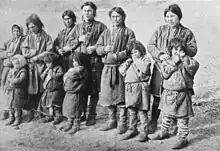 Kets | |
| Total population | |
|---|---|
| c. 1,100 | |
| Regions with significant populations | |
| Krasnoyarsk Krai (Russia) | |
| 1,088 (2021)[1] | |
| 40 (2001)[2] | |
| Languages | |
| Ket, Russian | |
| Religion | |
| Russian Orthodoxy, Animism, Shamanism | |
| Related ethnic groups | |
| Yugh people | |
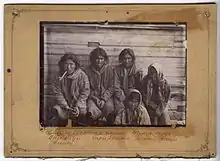 | |
 Shown within Russia | |
| Location | Most Ket live on the middle Yenisei River and tributaries, including a group in the community of Kellog. |
|---|---|
| Coordinates | 62°29′N 86°16′E |
Origin
The Ket people share their origin with other Yeniseian people and are closely related to other Indigenous people of Siberia and Indigenous peoples of the Americas. They belong mostly to Y-DNA haplogroup Q-M242.[4]
According to a 2016 study, the Ket and other Yeniseian people originated likely somewhere near the Altai Mountains or near Lake Baikal. It is suggested that parts of the Altaians are predominantly of Yeniseian origin and closely related to the Ket people. The Ket people are also closely related to several Native American groups. According to this study, the Yeniseians are linked to the Paleo-Eskimo groups. [5]
History
The Kets are thought to be the only survivors of an ancient nomadic people believed to have originally inhabited central and southern Siberia. In the 1960s, the Yugh people were distinguished as a separate, though similar, group.
Today, Kets are the descendants of fishermen and hunter tribes of the Yenisei taiga, who adopted some of the cultural ways of those original Ket-speaking tribes of South Siberia. The earlier tribes engaged in hunting, fishing, and reindeer breeding in the northern areas.[1]
The Ket was incorporated into the Russian state in the 17th century. Their efforts to resist were unsuccessful as the Russians deported them to different places in an attempt to break up their resistance. This broke up their strictly organized patriarchal social system and their way of life disintegrated. The Ket people ran up debts with the Russians. Some died of famine, others of diseases introduced from Europe. By the 19th century, the Ket could no longer sustain itself without food assistance from the Russian state.[6]
In the 20th century, the Soviets conducted collectivization among the Ket. They were officially recognized as Kets in the 1930s when the Soviet Union began to implement the self-definition policy for indigenous peoples. However, many Ket traditions continued to be counteracted by the state. Collectivization was completed by the 1950s, and the Ket people were led to adopt the same lifestyle as ethnic Russians; education in Russian contributed to language loss as well.
The population of Kets has been relatively stable since 1923. According to the 2010 census, there were 1,220 Kets in Russia. The Kets live in small villages along riversides and are no longer nomadic.
Language
The Ket language has been linked to the Na-Dené languages of North America in the Dené–Yeniseian language family.[7][8][9] This link has led to some collaboration between the Ket and northern Athabaskan peoples. [10] Although a potential link to the Na-Dené languages has been identified, this link is not accepted by all linguists. [11]
Ket means "man" (plural deng "men, people"). The Kets of the Kas, Sym and Dubches rivers use jugun as a self-designation. In 1788, Peter Simon Pallas was the earliest scholar to publish observations about the Ket language in a travel diary.[12]
In 1926, there were 1,428 Kets, of whom 1,225 (85.8%) were native speakers of the Ket language. The 1989 census counted 1,113 ethnic Kets with only 537 (48.3%) native speakers left.
As of 2008, there were only about 100 people who still spoke Ket fluently, half of them over 50.[7] It is entirely different from any other language in Siberia.[1] Alexander Kotusov (1955–2019) was a Ket folk singer, composer, and writer of songs in the Ket language.[13]
Culture
The Kets have a rich and varied culture, filled with an abundance of Siberian mythology, including shamanistic practices and oral traditions. Siberia, the area of Russia in which the Kets reside, has long been identified as the originating place of the Shaman or Shamanism. In the 1950s, Mircea Eliade states this in the first sentence of his book Shamanism: "Since the beginning of the 20th century, ethnologists have fallen into the habit of using the terms 'shaman', 'medicine man', 'sorcerer', and 'magician' interchangeably to designate certain individuals possessing magico-religious powers and found in all 'primitive' societies. If the word 'shaman' is taken to mean any magician, sorcerer, medicine man, or ecstatic found throughout the history of religion and religious ethnology, we arrive at a notion at once extremely complex and extremely vague; it seems, furthermore, to serve no purpose, for we already have the terms 'magician' or 'sorcerer' to express notions as unlike and ill-defined as 'primitive magic' or 'primitive mysticism'."[14]
The shamans of the Ket people have been identified as practitioners of healing as well as other local ritualistic spiritual practices. Supposedly, there were several types of Ket shamans,[15][16] differing in function (sacral rites, curing), power, and associated animals (deer, bear).[16] Also, among Kets, (as with several other Siberian peoples such as the Karagas[17][18][19]) there are examples of the use of skeleton symbolics.[20] Hoppál interprets it as a symbol of shamanic rebirth,[21] although it may also symbolize the bones of the loon (the helper animal of the shaman, joining the air and underwater worlds, just like the story of the shaman who traveled both to the sky and the underworld).[22] The skeleton-like overlay represented shamanic rebirth among some other Siberian cultures as well.[23][20]
Today, the practice of shamanism has largely been abandoned. Monotheism has displaced the ideas of the shaman and shamanistic practices. Of great importance to Kets are spirit images, described as "an animal shoulder bone wrapped in a scrap of cloth simulating clothing."[24] One adult Ket, who had been careless with a cigarette, said, "It's a shame I don't have my doll. My house burnt down together with my dolls."[25] Kets regard their spirit images as household deities, which sleep in the daytime and protect them at night.[26]
Edward J. Vajda, a professor of Modern and Classical languages, spent a year in Siberia studying the Ket people, and found a relationship between the Ket language and the Na-Dene languages, of which Navajo is the most prominent and widely spoken.[27]
Vyacheslav Ivanov and Vladimir Toporov compared Ket mythology with those of speakers of Uralic languages, assuming in the studies that they are modeling semiotic systems in the compared mythologies. They have also made typological comparisons.[28][29] Among other comparisons, possibly from Uralic mythological analogies, the mythologies of Ob-Ugric peoples[30] and Samoyedic peoples[31] are mentioned. Other authors have discussed analogies (similar folklore motifs, purely typological considerations, and certain binary pairs in symbolics) may be related to a dualistic organization of society - some dualistic features can be found in comparisons with these peoples.[32] However, for Kets, neither dualistic organization of society[33] nor cosmological dualism[34] have been researched thoroughly. If such features existed at all, they have either weakened or remained largely undiscovered.[33] There are some reports of a division into two exogamous patrilinear moieties,[35] folklore on conflicts of mythological figures, and cooperation of two beings in the creation of the land,[34] the motif of the earth-diver.[36] This motif is present in several cultures in different variants. In one example, the creator of the world is helped by a waterfowl as the bird dives under the water and fetches earth so that the creator can make land out of it. In some cultures, the creator and the earth-fetching being (sometimes called a devil, or taking the shape of a loon) compete with one another; in other cultures (including the Ket variant), they do not compete at all, but rather collaborate.[37]
However, if dualistic cosmologies are defined in a broad sense, and not restricted to certain concrete motifs, then their existence is more widespread; they exist not only among some Uralic-speaking peoples, but in examples on every inhabited continent. [38]
The Ket traditional culture has been researched extensively. Some people included as reference are Matthias Castrén, Vasiliy Ivanovich Anuchin, Kai Donner, Hans Findeisen, and Yevgeniya Alekseyevna Alekseyenko.[39]
1913 photographs by the Norwegian explorer Fridtjof Nansen:
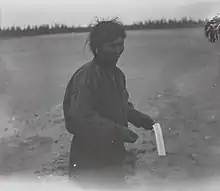
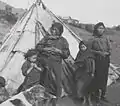

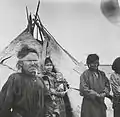
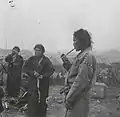
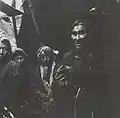
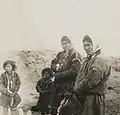

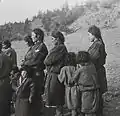
 Houseboats of the Ket
Houseboats of the Ket Group of Kets around a campfire. The people in the background wearing fur hats are Russians.
Group of Kets around a campfire. The people in the background wearing fur hats are Russians.
Notable Kets
- Alexander Kotusov, Ket singer
References
- Vajda, Edward G. "The Ket and Other Yeniseian Peoples". Archived from the original on 6 April 2019. Retrieved 29 June 2007.
- Ukrcensus.gov.ua
- "Ket: Bibliographical guide". Institute of Linguistics (Russian Academy of Sciences) & Kazuto Matsumura (Univ. of Tokyo). Retrieved 20 October 2006.
- Karafet, TM; Osipova, LP; Gubina, MA; Posukh, OL; Zegura, SL; Hammer, MF (2002). "High Levels of Y-Chromosome Differentiation among Native Siberian Populations and the Genetic Signature of a Boreal Hunter-Gatherer Way of Life". Hum Biol. 74 (6): 761–89. doi:10.1353/hub.2003.0006. PMID 12617488. S2CID 9443804.
- Flegontov, Pavel; Changmai, Piya; Zidkova, Anastassiya; Logacheva, Maria D.; Flegontova, Olga; Gelfand, Mikhail S.; Gerasimov, Evgeny S.; Khrameeva, Ekaterina E.; Konovalova, Olga P.; Neretina, Tatiana; Nikolsky, Yuri V.; Starostin, George; Stepanova, Vita V.; Travinsky, Igor V.; Tříska, Martin; Tříska, Petr; Tatarinova, Tatiana V.; Tatarinova, Tatiana V. (2015). "Genomic study of the Ket: A Paleo-Eskimo-related ethnic group with significant ancient North Eurasian ancestry". Scientific Reports. 6: 20768. arXiv:1508.03097. Bibcode:2016NatSR...620768F. doi:10.1038/srep20768. PMC 4750364. PMID 26865217.
- "THE KETS". The Peoples of the Red Book. Retrieved 5 August 2006.
- "Ket language family linked to Na-Dene language family | orbis quintus". 10 March 2008. Archived from the original on 23 July 2011. Retrieved 22 June 2016.
- "Public Lecture: The Siberian Origin of the Na-Dene Languages". University of Alaska Fairbanks. 12 February 2008. Archived from the original on 28 May 2009. Retrieved 22 June 2016.
- "Dene-Yeniseic Symposium, February 2008". University of Alaska Fairbanks. 10 February 2008. Archived from the original on 26 May 2009. Retrieved 22 June 2016.
- "The Arctic Athabaskan Council and the Ket People of Siberian Russia Renew Historic Contacts and Agree to Work Together | Talking Alaska". talkingalaska.blogspot.com. 21 April 2010. Retrieved 22 June 2016.
- "Ket, Its Viability and Revival Prospects" (PDF). Kevin Andrusky. 9 December 2013. Retrieved 26 October 2022.
- "Ket language". Encyclopedia Britannica. Retrieved 7 April 2021.
- Siberian Lang – Alexander Maksimovich Kotusov
- Mircea Eliade, Shamanism: Archaic Techniques of Ecstasy (Princeton, N.J.: Princeton University Press, 1972) 5
- Alekseyenko 1978
- Hoppál 2005: 171
- Diószegi 1960: 128, 188, 243
- Diószegi 1960: 130
- Hoppál 1994: 75
- Hoppál 2005: 172
- Hoppál 1994: 65
- Hoppál 2005: 198
- Hoppál 2005: 199
- A. A. Malygna, Dolls of the Peoples of Siberia 1988, p. 132, cited in Edward J. Vajda, Yeniseian Peoples and Languages: A History of Yeniseian Studies with an annotated bibliography and a source guide, Curzon Press, 2001.
- Werner Herzog, Happy People: A Year in the Taiga (documentary film) 2010.
- Herzog
- University, Western Washington (9 March 2021). "How 30 years of research built a language bridge between the peoples of Siberia and North America". Medium. Retrieved 9 April 2021.
- Ivanov & Toporov 1973
- Ivanov 1984:390, in editorial afterword by Hoppál
- Ivanov 1984: 225, 227, 229
- Ivanov 1984: 229, 230
- Ivanov 1984: 229–231
- Zolotaryov 1980: 39
- Zolotaryov 1980: 48
- Zolotaryov 1980: 37
- Ivanov 1984: 229
- Paulson 1975 :295
- Zolotarjov 1980: 56
- Hoppál 2005: 170–171
Further reading
- Alekseyenko, E. A. (1978). "Categories of Ket Shamans". In Diószegi, Vilmos; Hoppál, Mihály (eds.). Shamanism in Siberia. Budapest: Akadémiai Kiadó.
- Diószegi, Vilmos (1960). Sámánok nyomában Szibéria földjén. Egy néprajzi kutatóút története. Terebess Ázsia E-Tár (in Hungarian). Budapest: Magvető Könyvkiadó. The book has been translated to English: Diószegi, Vilmos (1968). Tracing shamans in Siberia. The story of an ethnographical research expedition. Translated from Hungarian by Anita Rajkay Babó. Oosterhout: Anthropological Publications.
- Hoppál, Mihály (1994). Sámánok, lelkek és jelképek (in Hungarian). Budapest: Helikon Kiadó. ISBN 963-208-298-2. The title means "Shamans, souls and symbols".
- Hoppál, Mihály (2005). Sámánok Eurázsiában (in Hungarian). Budapest: Akadémiai Kiadó. ISBN 963-05-8295-3. The title means "Shamans in Eurasia", the book is written in Hungarian, but it is published also in German, Estonian and Finnish. Site of publisher with a short description on the book (in Hungarian) Archived 2 January 2010 at the Wayback Machine
- Ivanov, Vyacheslav; Vladimir Toporov (1973). "Towards the Description of Ket Semiotic Systems". Semiotica. The Hague • Prague • New York: Mouton. IX (4): 318–346.
- Ivanov, Vjacseszlav (=Vyacheslav) (1984). "Nyelvek és mitológiák". Nyelv, mítosz, kultúra (in Hungarian). Collected, appendix, editorial afterword by Hoppál, Mihály. Budapest: Gondolat. ISBN 963-281-186-0. The title means: "Language, myth, culture", the editorial afterword means: "Languages and mythologies".
- Ivanov, Vjacseszlav (=Vyacheslav) (1984). "Obi-ugor és ket folklórkapcsolatok". Nyelv, mítosz, kultúra (in Hungarian). Collected, appendix, editorial afterword by Hoppál, Mihály. Budapest: Gondolat. pp. 215–233. ISBN 963-281-186-0. The title means: "Language, myth, culture", the chapter means: "Obi-Ugric and Ket folklore contacts".
- Middendorff, A. Th., von (1987). Reis Taimхrile. Tallinn.
{{cite book}}: CS1 maint: location missing publisher (link) CS1 maint: multiple names: authors list (link) - Paulson, Ivar (1975). "A világkép és a természet az észak-szibériai népek vallásában". In Gulya, János (ed.). A vízimadarak népe. Tanulmányok a finnugor rokon népek élete és műveltsége köréből (in Hungarian). Budapest: Európa Könyvkiadó. pp. 283–298. ISBN 963-07-0414-5. Chapter means: "The world view and the nature in the religion of the North-Siberian peoples"; title means: "The people of water fowls. Studies on lifes and cultures of the Finno-Ugric relative peoples".
- Zolotarjov, A.M. (1980). "Társadalomszervezet és dualisztikus teremtésmítoszok Szibériában". In Hoppál, Mihály (ed.). A Tejút fiai. Tanulmányok a finnugor népek hitvilágáról (in Hungarian). Budapest: Európa Könyvkiadó. pp. 29–58. ISBN 963-07-2187-2. Chapter means: "Social structure and dualistic creation myths in Siberia"; title means: "The sons of Milky Way. Studies on the belief systems of Finno-Ugric peoples".
External links
![]() Media related to Ket people at Wikimedia Commons
Media related to Ket people at Wikimedia Commons